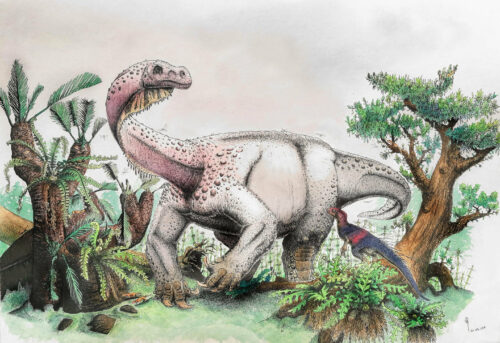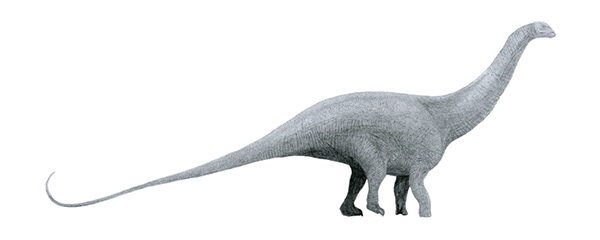
Last month, researchers announced the discovery of an enormous dinosaur in South Africa. Ledumahadi mafube (which means “giant thunderclap at dawn” in the Sotho language) weighed as much as two elephants and lived around 200 million years ago. Scientists were surprised to find that such a big dinosaur was so ancient. L. mafube was the largest dinosaur known from its time, and the closely related sauropods (true behemoths which grew to be seven times as large as L. mafube and included the largest land animals ever) achieved their massive sizes much later. Evidence also suggests that this new dinosaur walked on four legs — a finding that highlights the fact that evolution represents a blossoming of diversity, not a linear march of “advancement” along a set track.
Where's the evolution?
Scientists recovered only a handful of (very large) bones from L. mafube. To determine whether this dinosaur walked on two legs (bipedally, as Tyrannosaurus rex did) or four (quadrupedally, as Brontosaurus did), researchers relied on a simple measurement: the circumference of the humerus (the equivalent of your upper arm) in comparison to that of the femur (the thigh bone). Unsurprisingly, in all living land animals (and in extinct ones for which stance is well documented in other ways), there is a consistent relationship between these figures. Quadrupeds have a thicker “arm” bone in comparison to their thigh bone than do bipeds. This makes sense. Quadrupeds would only be able to support their weight with their front legs if those bones were sturdy. And L. mafube had a sturdy “arm” bone, putting it squarely in the range of four-legged walkers. However, reconstructions suggest that its forelegs had a flexed position, splaying to the sides of its body, unlike the four-legged sauropod Brontosaurus, which stood on four legs positioned like columns beneath its enormous body as an elephant does. L. mafube walked on four legs, but it could probably also have reared up on its hind legs and used its front legs for foraging.

The overall picture of dinosaur diversity also contradicts common misconceptions about evolution. It’s now well established that birds are actually dinosaurs (since the attachment point for the avian branch of the Tree of Life nests within the dinosaur clade). It might be tempting to envision an evolutionary transition from lumbering four-legged titan, to a nimble bipedal velociraptor, to an actual bird running on two legs until it eventually takes flight. But as we’ve seen time and time again, evolution doesn’t follow a linear path — and rarely does that path conform to our idea of what might constitute “advancement.” In fact, the ancestor of all dinosaurs was almost certainly already bipedal — and several different quadrupedal dinosaur groups evolved from this ancestor, going from two legs to four. There’s nothing more “advanced” about walking on two legs.
Further, birds were not the “goal” of dinosaur evolution. Non-bird dinosaurs lived on Earth for nearly 200 million years, and the first birds arose about halfway through that span and evolved flight shortly after. Birds were flapping around alongside other earthbound dinosaurs for around 100 million years before the rest of their clade was rendered extinct. It is easy to misconstrue birds as the capstone achievement of dinosaur evolution, but in fact they are merely the lucky survivors.
As scientists discover more fossils and new species like L. mafube, the dinosaur branch of the Tree of Life is being filled out. And as it is, we find more and more examples reinforcing the idea that evolution is not a march of progress. Instead it is a blossoming of exuberant diversity generated in response to the assorted forces, accidents, and vagaries of a complex environment and Earth’s unique history.
Primary literature:
- McPhee, B. W., Benson, R. B. J., Botha-Brink, J., Bordy, E. M., and Choiniere, J. N. (2018). A giant dinosaur from the earliest Jurassic of South Africa and the transition to quadrupedality in early sauropodomorphs. Current Biology. 28: 1-9. Read it »
News articles:
Understanding Evolution resources:
- In your own words, explain the evidence suggesting that L. mafube walked on four legs.
- What aspect of sauropodomorph evolution illustrates the fact that evolution does not represent a linear march of ‘advancement?’
- Do some research online and describe a different case in which evolution has changed course and “reversed” itself.
- Advanced: An article in the journal Nature described L. mafube’s flexed stance as an “evolutionary ‘experiment.'” In what ways is this description accurate and in what ways could it be misleading?
- Advanced: To determine whether L. mafube walked on two legs or four, researchers compared measurements from living and extinct species and extrapolated based on those. Do you think this constitutes strong or weak evidence for how L. mafube walked? Explain your reasoning.
- Teach about how scientists learn about the past: This web-based module for grades 6-12 provides students with a basic understanding of how fossils can be used to interpret the past.
- Teach about transitional forms: This news brief for grades 9-16 describes the discovery of a new mammal species that highlights just how long mammals have been around and debunks the notion of a "missing link."
- Assess student misconceptions about natural selection: In this 12-item multiple-choice evolution test for grades 9-16, wrong answers are designed to tap into common student misconceptions. It can be used to diagnose evolution misconceptions related to natural selection and to assess the effectiveness of instruction in helping students overcome their misconceptions.
- Lloyd, G. T., Bapst, D. W., Friedman, M., and Davis, K. E. (2016). Probabilistic divergence time estimation without branch lengths: dating the origins of dinosaurs, avian flight and crown birds. Biology Letters. 12: 20160609.
- McPhee, B. W., Benson, R. B. J., Botha-Brink, J., Bordy, E. M., and Choiniere, J. N. (2018). A giant dinosaur from the earliest Jurassic of South Africa and the transition to quadrupedality in early sauropodomorphs. Current Biology. 28: 1-9.
